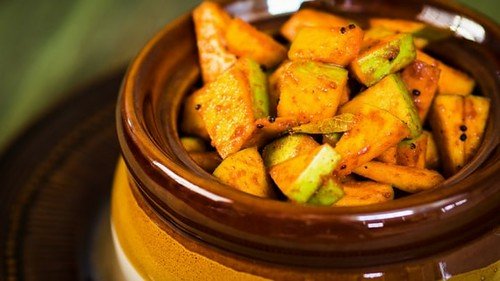Read in : தமிழ்
March and April were pickle season at home when we were children and the smell of salted mangoes filled the house. It was to fun to open the piece of muslin cloth that covered the tall porcelain jars of chopped and marinating fruit and pick a piece to taste it instantaneously without our mother’s knowledge or having to wait weeks for the pickle to be ready. With everything now available ready-to-eat, children of today have been robbed of this childhood fun.
Seasonal fruits and vegetables are often preserved to extend their shelf life. Preservatives help in preventing spoilage and salt is one of the oldest such preservatives that humans have used for centuries. Salt or a percentage of salt in water known as brine prevents rotting of vegetables. The various methods of salting vegetables and fruits for later use is called pickling. The term pickle comes from the Dutch word “Pekel” meaning salt or brine.
Pickles have been around now for nearly 4,000 years and are used globally as part of regular diets. Many famous personalities come to mind when we speak about pickles. To name a few, Christopher Columbus travelled on his great voyages of discovery with pickles to overcome sea sickness; Amerigo Vespucci, a ship chandler also known as “Pickle Dealer” was the one who prepared pickles and supplied them for crew members; Cleopatra is said to have used pickles to maintain her beauty and health and Napoleon is said to have to triggered the quest for extending the life of pickles leading to the invention of the canning process by Nicholas Appert. Even during the construction of the Great Wall of China, pickled vegetables were given to labourers. Pickling is the first and oldest preservation technique.
Indian Cucumbers were the first vegetables to be pickled and marketed. Salted amla or gooseberry was used by sailors to heal and help themselves during sea sickness. In fact, it was pickle manufacturers who helped in the formation of US Food and Drug Administration or FDA which now plays a crucial role in checking the safety and security of food products in that country. Indian pickles are very spicy and have good taste, flavour, texture and consistency. The famous comedian Mr. Vivek’s dialog stating pickle as the best side dish ever is all time favourite dialogue among Tamils. That’s because of the strong tangy and spicy taste it releases when it touches the taste buds.
The various methods of salting vegetables and fruits for later use is called pickling. The term pickle comes from the Dutch word “Pekel” meaning salt or brine
Generally, pickles are of two types: Fermented and non-fermented pickles. Fermented pickles are made by soaking the vegetable in brine (salt dissolved in water) for few days and waiting for the growth of microorganisms that convert the vegetable into a desired texture and taste. One such is Kimchi, the famous Korean cabbage pickle, loaded with nutrients and probiotics. In India, lemon, citron, mango, and gooseberry are allowed to ferment in brine or salted for weeks, sometimes months and then seasoned with spices and chilli powder to make them even more palatable. In some cases, vinegar is added to create an acidic environment and in traditional method, excess oil is added to prevent external entry of pathogens.
Also Read:
Steamed food: Tips to make the trendy ones healthy
Plant-based meat: Just a pricey lifestyle choice?
The only drawback in pickles is the high sodium content which retards the growth of harmful microorganisms. However, the high sodium levels make pickles a strict no-no for those with cardiovascular diseases. Fresh packed pickles are usually non-fermented. This is what we get from super markets with chemical preservatives lacking the unique flavour and taste of marinated pickles. The chemical preservatives used in pickles are sodium benzoate, citric acid and in case of meat-based pickles, sodium nitrate and sodium nitrites added to retain the colour.
In recent research on pickles, scientists found that the pickled juice of fruits helps in relieving muscle cramps in athletes. A research group (Elliot et. Al, 2022) reported that sip of pickle juice at the onset of cramps reduced the severity of muscle cramps. According to the scientists, acetic acid helps in the process of reducing muscle cramps.
The only drawback in pickles is the high sodium content which retards the growth of harmful microorganisms. However, the high sodium levels make pickles a strict no-no for those with cardiovascular diseases
Pickles are strong spicy food loaded with health benefits but best used in small amounts. Such foods should always carry the traditional touch and taste and not of chemicals. Let us prepare our own pickles and let our children taste and enjoy the traditional pickles at home as we did. Spend the weekend learning from older folks asking about the quantity of pickles they prepare at home every year and how long they use it!
Tips about pickling and pickles
- Beginners can learn to prepare pickles in summer to avoid contamination
- Always use a dry spoon while consuming pickles during meal time to avoid moisture addition to the pickles. Wet spoons increase the chances of contamination.
- Take sufficient portion of brined product for seasoning and repeat the process whenever necessary.
- Store pickles in air tight jars/bottles and frequently place in sunlight to control the growth of pathogens.
- Carry few pieces of pickled mango or amla to overcome travel sickness and pickle juice to overcome muscle cramps.
Read in : தமிழ்











